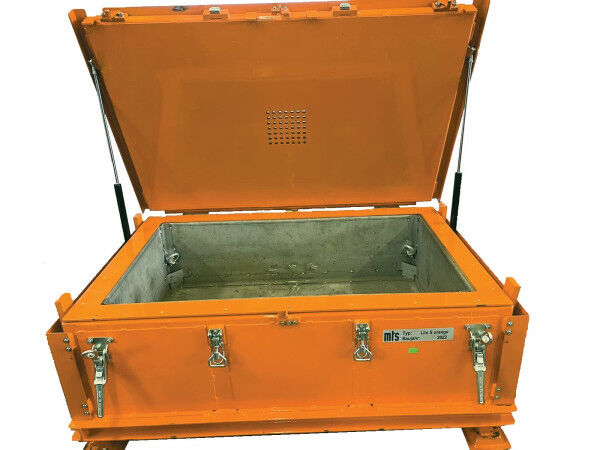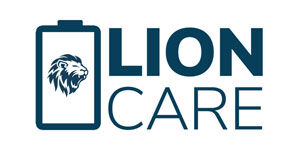
Free shipping (Germany, mainland)!
Shippingtime: ca. 10 Wo.
- Article no: MTSVG2LOS

Questions about the article?
Our staff member Petra Fürbeck is happy to help you:
+49 (0) 7151 - 256 4817 or info@lion-care.com
| max. gross mass: | 739 kg |
| Handling the filling material: | Fire protection ceiling, Filling material around inserts |
| max. net dangerous goods mass: | 400 kg |
| Material name: | Steel (painted) |
| Volume: | 149 l |
| Packaging group: | Packaging group I |
| Packaging instructions according to ADR: | PI 903, LP 903, PI 908, PI 910, LP 904, LP 905 |
| ADR special provision: | SP 310, SP 376, SP 377 |
| UN packaging code: | 50A/X/.. .../D/BAM 16018-mts/1500/739 |
| Areas of application: | Automotive, Workshop, Transport of rechargeable batteries, Prototypes, Waste disposal, Transportation, Storage |
| External dimensions: | 1200 x 800 x 533 mm |
| Filling material: | mts granules |
| Internal dimensions: | 965 x 565 x 250 mm |
The LiioBox Orange is perfect for storing and transporting defective cells, modules or entire lithium-ion batteries.
Size and capacity of the battery transport container
The LiioBox for (non-critical) defective lithium-ion batteries has external dimensions of 1200 x 800 x 533 mm. The dimensions inside the transport box are 965 x 565 x 250 mm. The maximum permissible battery weight is 400 kg. This container is therefore primarily used for industrial applications. Industrial trucks can drive under the container. The lid can be easily lifted using gas pressure springs.
Optimum safety thanks to the double-walled housing and special granulate
The collection basin is made of an e-insulated stainless steel tray, which is filled with mts granulate. The insulation between the outer tray and the casing is patented and unique on the market. A fire protection blanket with fiberglass cushions is used inside the box. The container also has a flame arrester and overpressure protection in the event of degassing.
Other versions possible
The LiioBox can also be manufactured in other sizes on request. There is also the option of installing both battery temperature monitoring and GPS localization. If you require this, please do not hesitate to contact us.
Certification and guidelines
Lithium-ion batteries and lithium-ion rechargeable batteries fall into dangerous goods class 9, which means that the goods pose a risk to the environment during transportation that should not be underestimated. Numerous specifications and guidelines must therefore be observed when transporting lithium-ion batteries / lithium-ion rechargeable batteries. The LiioBox transport box has been specially designed for the strictest safety regulations.
For packaging instruction LP 904/P908 (non-critically defective), and LP 905/P910 (prototypes) according to SV 310, SV 376
With this system it is possible to transport (non-critically) defective lithium batteries in accordance with LP 904/P 908 and prototypes in accordance with special regulation SV 310 and packaging instruction LP 905/P 910. The filling material used around the insert is neither electrically conductive nor flammable. Please contact us if required.
Also ideal for transporting new lithium-ion batteries in accordance with P903 / LP 903 and as a storage and quarantine box
The container is also ideal as a quarantine container for defective batteries to isolate a possible fire from the outset. In addition to defective batteries, the transport container is also suitable for the regular shipment of new goods in accordance with packaging regulation P 903/LP 903
About mts Maschinenbau GmbH
Since its foundation in 1996, mts Maschinenbau GmbH has stood for innovative products and the highest quality of load carriers for automation. Since 2016, the company from Mengen (Baden-Württemberg) has also been developing transport solutions for both intact and defective lithium-ion batteries. in 2020, mts Maschinenbau GmbH is one of the TOP 100 most innovative medium-sized companies in Germany. Production sites are located in Mengen (D), Chesterfield (USA) and Swiebodzice (PL).
Future-oriented
Lithium-ion batteries will be indispensable in all industrial applications in the coming years. However, if used improperly, batteries can pose a potential hazard during production, storage and transportation that should not be underestimated. By purchasing these boxes, you protect yourself against major financial losses right from the start. International customers from the automotive and energy supply sectors, among others, rely on this proven technology.
In use for you
If you have any questions, please do not hesitate to contact us. We look forward to hearing from you!
| Suitable for critically defective?: | No |
| max. gross mass: | 739 kg |
| Handling the filling material: | Fire protection ceiling, Filling material around inserts |
| Type: | Storage box |
| Material: | Steel |
| Type of packaging: | Large hazardous goods packaging (LP) |
| Volume: | 84 - 600 l |
| Filling material supplied: | Expanded glass granulate (bulk material) |
| max. net dangerous goods mass: | 400 kg |
| Coding: | 50A |
| Material name: | Steel (painted) |
| Volume: | 149 l |
| Packaging group: | Packaging group I |
| Packaging instructions according to ADR: | PI 903, LP 903, PI 908, PI 910, LP 904, LP 905 |
| ADR special provision: | SP 310, SP 376, SP 377 |
| UN packaging code: | 50A/X/.. .../D/BAM 16018-mts/1500/739 |
| Areas of application: | Automotive, Workshop, Transport of rechargeable batteries, Prototypes, Waste disposal, Transportation, Storage |
| External dimensions: | 1200 x 800 x 533 mm |
| Filling material: | mts granules |
| Internal dimensions: | 965 x 565 x 250 mm |
That depends on various factors that need to be considered:
- size of the battery(ies)
- condition (e.g. non-critical, defective, critically defective or prototype)
- power
Transport boxes are available in many different sizes and specifications. The packaging group for which the box is suitable is indicated for each product.
Find out more in our blog article:
https://www.lion-care.com/aktuelles/blog/transportvorschriften-regeln-und-sicherheitsmassnahmen
Even if the batteries are not critical, remember to protect them from shocks and to order appropriate filling material if it is not already included in the box.
Yes. Should a battery reach a critical state and cause a fire, separating the batteries will prevent the fire from spreading and multiplying.
Generally, the insulation and protection material should line all sides of the container. The batteries are stored between individual layers.
We also have containers in our program that already have the protective material integrated into the outer wall. No further protective layer is necessary here.
The technical principles for storage and transportation solutions are very similar. The transport boxes are also subjected to extensive tests in accordance with ADR (drop test, fire test, etc.) to confirm compliance with the ADR regulations. The packaging regulations are extensive and regulated by law.
There are currently no comparable regulations for storage. Nevertheless, manufacturers of storage boxes regularly carry out appropriate tests.
The right container depends on the type and size of the battery to be shipped or stored.
If you want to learn more about battery storage and transportation, you will find the answers in our blog articles:
https://www.lion-care.com/aktuelles/blog/transportvorschriften-regeln-und-sicherheitsmassnahmen
https://www.lion-care.com/aktuelles/blog/lithium-ionen-akkus-sicherer-umgang-und-richtige-lagerung
The transportation of batteries is subject to ADR regulations.
The number, size and weight, energy density and condition of the batteries are crucial parameters for finding a suitable transport container for lithium-ion batteries. The selection process is complex and should be carried out by appropriately trained personnel. We have a trained hazardous materials officer on our team. Please feel free to contact us.
Plastic containers are cheaper but not as durable as metal containers. They are suitable, for example, for non-critical batteries, defective batteries, prototypes and end-of-life batteries. They can be used for both storage and transportation.
Metal containers are required, for example, when dealing with critically defective batteries.
The exact packaging instructions for these cases can be found in the ADR or by consulting a certified hazardous materials specialist.
To date, there are no legal requirements for the storage of lithium-ion batteries, which does not mean that they should be stored without suitable protective measures.
It is best to check with your insurer to find out which measures they recognize as suitable in the event of a claim.
For example, a suitable box could already be recognized as spatial separation.
A rough overview can be found in this VDS publication from the GDV:
https://shop. vds.de/download/vds-3103/ccb1d439-ad9d-47cb-a2b1-ace23e155610
Please also read our blog article on this topic:
https://www.lion-care.com/aktuelles/blog/lithium-ionen-akkus-sicherer-umgang-und-richtige-lagerung



